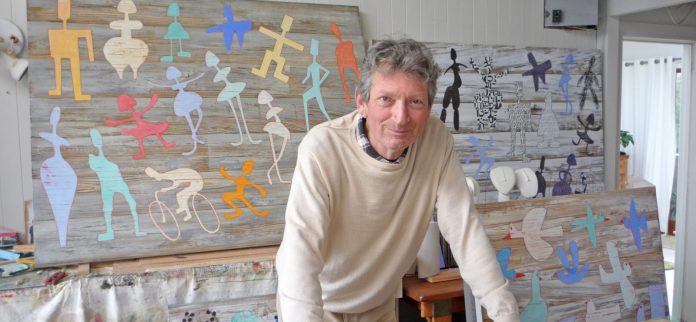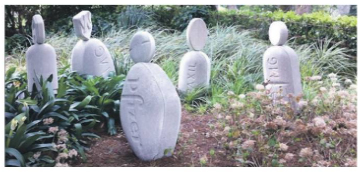Waiheke Gulf News 10 Ocotober 2019
In Oneroa Village a blue behatted figure strides purposefully towards the entry of [space] gallery – its creator Paul Radford, one of the seven-member artist collective who show their work there. A well established artist, Paul had his first exhibition aged 16 and more than 30 solo shows since. His work is held in collections including those of the Auckland City Gallery, Christchurch Art gallery and Te Papa Tongarewa, and he is a three time participant in Sculpture on the Gulf.
He works in a wide variety of media including bronze, glass, polystyrene, plywood, and driftwood. His 2011 Sculpture on the Gulf sculpture Prodigal Child, with its tombstone forms commenting on society’s overdependence on pharmaceuticals, was created in hardcore and polystyrene. His readiness to explore form and media may owe more than a little to the years he spent as a scene painter for film and television, along with the problem solving that it demanded.
“It was really busy, really creative, very good, but you were constantly on a deadline,” he says, noting that on the Xena and Hercules shows they were completing about 20 sets a week. In the 1980s he had begun working with graffiti and cartoonlike figures. “As a young artist,” he says, “I think you are always looking at some other way of dealing with things, getting away from what you’ve been taught“
The cartoon figures appear among the range of forms he references in his painting and sculpture included, for example, in the group of figures in Sculpture Walk, his entry for SOTG 2015. He represents the human form in a variety of styles. Stick like figures arose from seeing distant figures from a Surfer’s Paradise high rise building and realising that, despite them being mere silhouettes, he could still identify their gender and recognise their body language. That awareness is evident in the careful stance and positioning of figures in his paintings. “Although it doesn’t look like it, the difference between where a foot lands is really critical, and whether that arm is right positioned on the hip there. It’s so subtle but it changes the whole thing.”
Some forms come from his interest in prehistory one derived from African rock painting 20,000 years ago. “The way the mind represents a form is really interesting. Most of them I’ve invented or redrawn. I think that’s a really good way to see the thing redraw it and redraw it again. It becomes more you a way of making something your own.”
One body of work developed from a specific form from 5000 years ago. “I kept thinking I wanted a motif that was really simple. I’d worked in film for so long and I had so many techniques that I liked, rusty old surfaces, woodgrain, broken paint surfaces I wanted to use anything that interested me, in a sample motif.” That motif would be a highly stylised female form from the Greek Cycladic period. “I thought there it is, so simple and so elegant. I could change the background change the head shape. It gave me this incredible vehicle within a very limited motif.”
Flotsam, his largescale sculpture from the 2009 SOTG exhibition, now in stalled in Alison Park, also takes this form.
TJ McNamara in an August 2008 New Zealand Herald review of what he called an impressive exhibition, “What gives Radford’s work distinction is the wonderful quality of the handling of paint in the background, whether expressing the texture of grained timber or the colour of heads themselves may be plain or monumental or filled with knowledge of numbers, codes or even the periodic table. Radford’s exhibitions are rare and have a special rich quality of their own.”
The woodgrain background mentioned by McNamara is key in many of Paul’s paintings. “Before the council cleaned up the boats down at Ostend, there used to be great bits of plywood and weathered stuff and I did work on them because they were gorgeous out and I had to go back to my scenic art to get those effects” The technique he has developed involves using wood graining tool over the canvas and peeling of thin layers of paint back to create a thoroughly convincing weathered wood background which his figures will populate. “When I came here six years ago, I had thia idea of putting all the things that had ever interested me right from art school, in one painting. So I ended up with these paintings which have got everything in them from ink blots, to Cycladic and tribal art, cartooning, signage, all meshed into one thing, like humanity jammed in, not only socially but historically and then there’s us right now.”
Each member of the [ space] gallery collective runs the gallery one day a week, a very different experience to Paul’s previous dealer galleries. “I like the independence and camaraderie of this,” he says. It also means more feedback. “People don’t know who you are sitting there, and you hear their comments. It’s a totally different thing. I never expected that.” Paul’s work can be viewed at [space] gallery in Oneroa village along with that of Kiya Nancarrow, Mary Ferguson, Katie Trinkle-Legge, Jay Lloyd, Olivier Duhamel, Maria Lloyd and guest artist Zoe Leeb duToit. See also PaulRadfordartist com and email the artist at p.radford8@ gmail.com.
Sandra Chesterman is an independent art researcher and writer. She can be contacted at artdiarywaiheke@gmail.com


